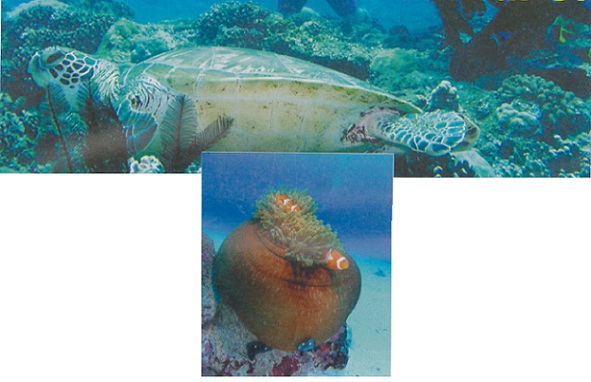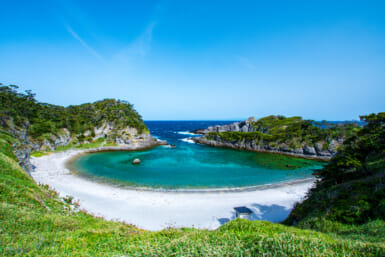by Charles T. Whipple
Enjoy Okinawa for a week (or even four days if that’s all the time off you can get) and you can come back, qualified to venture into Nemoland.
Rich Ruth, owner of a non-military English-speaking dive shop in Okinawa, met me in the Naha airport arrival lobby. “Come on, let’s get outta here,” he said, grasping the handle of my 30-kilo diving bag and heading for the door.
A moment later, in his shark-decorated van, his first words sounded as musical as a symphony: “Ready for a night dive?”
A few moments at Fathoms, Rich’s shop, let me check my camera, load strobe and diving-light batteries, and change into my swim trunks.
The sun kissed the horizon as we parked at Maeda Point. A hundred feet below us, the surf splashed against coral cliffs as we strode down concrete steps toward our entry point through the deepening dusk—scuba tanks and regulators on our backs, fins and masks in hand. Rich secured two chemical lights to the coral to mark our exit point.
Out in chest-high water, we donned our masks and fins and rolled off the reef into a black abyss. To the right, walls of coral. To the left, an underwater crevasse leading toward the dropoff.
Four shafts of light probed the water, searching for nocturnal sea life. Rich beckoned, then spotlighted a huge hermit crab in a conch shell.
Scrawled filefish dozed in mid-water. Baby spadefish reeled drunkenly in their sleep. Reef cuttlefish and octopus hunted in the night. Parrotfish slept in cocoons of mucus.
Sea urchins emerged from their rocky lairs to feed, and sea cucumbers munched their way across the sandy floor.
Too soon our life support systems warned that air was running low. We moved back up the crevice and, for a few minutes, turned out the lights. The vista went pale blue, like a moonlit night ashore. We waved our arms, exciting microscopic plankton into a frenzy of fluorescence — there’s nothing like being under the sea at night.
Reluctantly we left the water, and what a magnificent introduction to Okinawa!
GETTING CERTIFIED
The open water course costs ¥36,000 (half to one-third the price to get certified in Tokyo) at Fathoms. That includes classroom work, pool instruction, open water instruction and a final exam.
When certified, you’ll have five ocean dives under your belt. And if you stay an extra day or two, Rich will give you at least two, and maybe four, more dives with him at your side to build your confidence.
THE PERKS OF DIVING
To the certified diver, Okinawa offers tropical diving without having to get re-entry permits or other such Immigration-oriented rubbish. And terrific diving lies just off the beach.
I’ve already taken you to Maeda Point for a night dive. During the day, humongous pinnate spadefish (batfish to some) tag divers around like a flock of geese looking for a handout. The reef fish are out in force — blennies, damsels, clownfish, tangs, surgeonfish, cardinal fish, soldier fish, goatfish and many more.
Look up at the surface once in a while, because saury-pike and barracudas like to swim above you.
Fathoms also frequents other interesting beaches such as Onna Point (great for barbecues, too), Horseshoe, Sunabe and Kadena.
“In other places, you’d have to go out on a boat for the kind of diving you get from the beach in Okinawa,” Rich says.
Fathoms charges ¥7,000 for two beach dives, and an extra ¥1,000 if you want a third dive that day (or night) — pickups, dropoffs and lunch included.
That said, you’ll want to take one day to dive the Keramas, about an hour from Naha by boat. With Fathoms, two boat dives (lunch included) in the Keramas would cost you ¥12,000. Not bad.
When we went, our second dive was at Ariga-kita, a rather shallow spot where we wended our way among coral heads dotting a bottom of pure white sand. After some 30 minutes of pyramid angels, lionfish, saury-pike and moorish idols, we held an impromptu underwater long-jump competition.
We shed our fins and ran slow-motion over the sand to leap. Swimming was not allowed, and the longest “jump” was only about 10 meters.
Chuckling into our regulators, we donned our fins and started back, examining coral heads as we went. Still, I almost swam right past him. He was so cleverly camouflaged, you’d think he was another chunk of coral instead of a giant frogfish.
Okinawa’s a good place to hover and watch. The water’s clear — 100-ft. visibility is not uncommon — so you can hang there motionless, blending right into the scenery, and see critters you’d never notice if you kept moving all the time.
Okinawa was once a proud nation of seafaring traders that flourished on trade with China, Korea, Japan and islands to the south. Today, the former Ryukyu Kingdom is Japan’s poorest prefecture.
It also accommodates most of the U.S. military presence in Japan. Its streets and roads are crowded; its buildings and homes seem the worse for wear. But there’s something attractive about Okinawa.
Some go for the culture. Some go for the sun. Some, like me, go for the endlessly fascinating, constantly changing world beneath the surface of the Okinawan Sea.
COME FLY AWAY
JAL, JAS & ANA all have regular flights to Okinawa and prices vary depending on the season and when you book. Cheaper fares are usually available on the Internet and you can get some great package deals as well.
If you plan at least four nights (five days) in Okinawa, you can earn Open Water Diving certification from the Professional Association of Diving Instructors (PADI) and, as a certified scuba diver, you’re qualified to dive anywhere in the world, keeping in mind your level of skill, of course.









